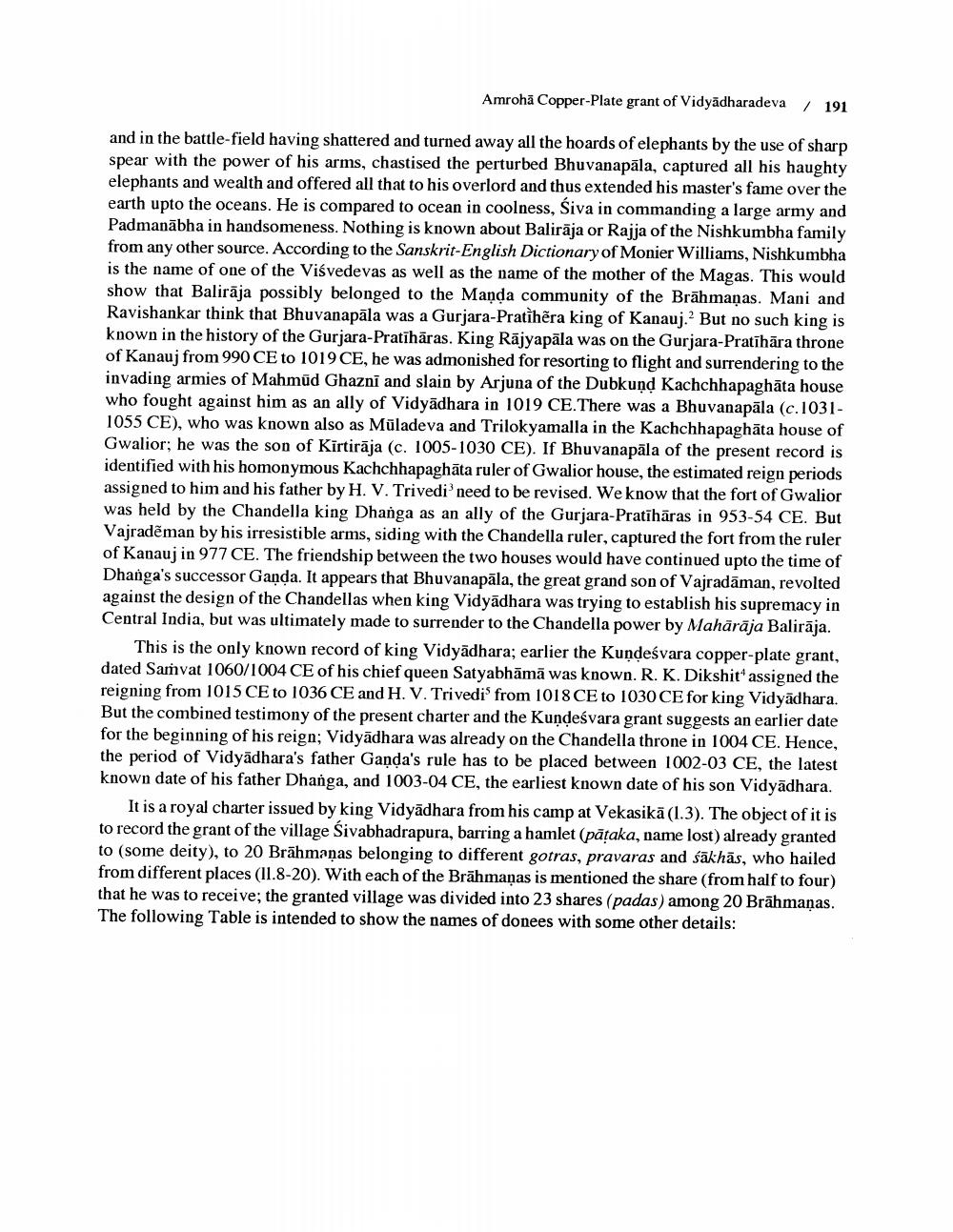________________
Amroha Copper-Plate grant of Vidyādharadeva / 191
and in the battle-field having shattered and turned away all the hoards of elephants by the use of sharp spear with the power of his arms, chastised the perturbed Bhuvanapāla, captured all his haughty elephants and wealth and offered all that to his overlord and thus extended his master's fame over the earth upto the oceans. He is compared to ocean in coolness, Siva in commanding a large army and Padmanābha in handsomeness. Nothing is known about Balirāja or Rajja of the Nishkumbha family from any other source. According to the Sanskrit-English Dictionary of Monier Williams, Nishkumbha is the name of one of the Visvedevas as well as the name of the mother of the Magas. This would show that Balirāja possibly belonged to the Manda community of the Brāhmanas. Mani and Ravishankar think that Bhuvanapāla was a Gurjara-Pratihēra king of Kanauj. But no such king is known in the history of the Gurjara-Pratīhāras. King Rājyapāla was on the Gurjara-Pratīhāra throne of Kanauj from 990 CE to 1019 CE, he was admonished for resorting to flight and surrendering to the invading armies of Mahmud Ghazni and slain by Arjuna of the Dubkund Kachchhapaghāta house who fought against him as an ally of Vidyādhara in 1019 CE. There was a Bhuvanapāla (c.10311055 CE), who was known also as Mūladeva and Trilokyamalla in the Kachchhapaghāta house of Gwalior; he was the son of Kirtirāja (c. 1005-1030 CE). If Bhuvanapāla of the present record is identified with his homonymous Kachchhapaghāta ruler of Gwalior house, the estimated reign periods assigned to him and his father by H. V. Trivedi' need to be revised. We know that the fort of Gwalior was held by the Chandella king Dhanga as an ally of the Gurjara-Pratīhāras in 953-54 CE. But Vajradēman by his irresistible arms, siding with the Chandella ruler, captured the fort from the ruler of Kanaujin 977 CE. The friendship between the two houses would have continued upto the time of Dhanga's successor Ganda. It appears that Bhuvanapāla, the great grand son of Vajradāman, revolted against the design of the Chandellas when king Vidyadhara was trying to establish his supremacy in Central India, but was ultimately made to surrender to the Chandella power by Mahārāja Balirāja.
This is the only known record of king Vidyādhara; earlier the Kundeśvara copper-plate grant, dated Samvat 1060/1004 CE of his chief queen Satyabhāmā was known. R. K. Dikshit' assigned the reigning from 1015 CE to 1036 CE and H. V. Trivedis from 1018 CE to 1030 CE for king Vidyādhara. But the combined testimony of the present charter and the Kundeśvara grant suggests an earlier date for the beginning of his reign; Vidyādhara was already on the Chandella throne in 1004 CE. Hence, the period of Vidyadhara's father Ganda's rule has to be placed between 1002-03 CE, the latest known date of his father Dhanga, and 1003-04 CE, the earliest known date of his son Vidyādhara.
It is a royal charter issued by king Vidyādhara from his camp at Vekasikā (1.3). The object of it is to record the grant of the village Sivabhadrapura, barring a hamlet (pāțaka, name lost) already granted to (some deity), to 20 Brāhmaṇas belonging to different gotras, pravaras and sākhās, who hailed from different places (11.8-20). With each of the Brāhmaṇas is mentioned the share (from half to four) that he was to receive; the granted village was divided into 23 shares (padas) among 20 Brāhmaṇas. The following Table is intended to show the names of donees with some other details:




